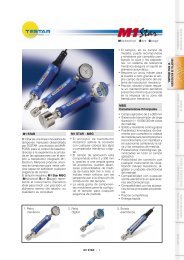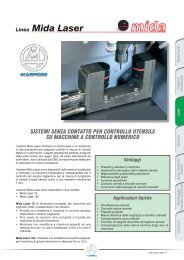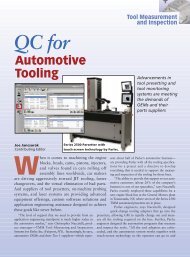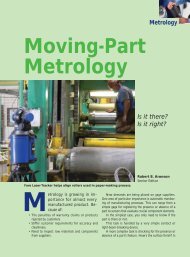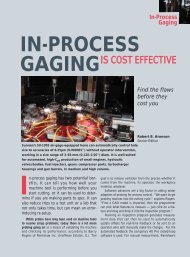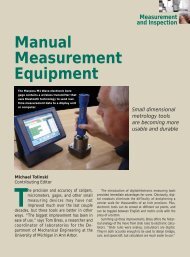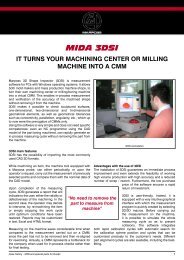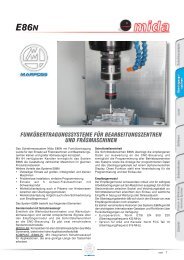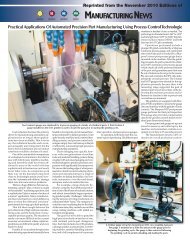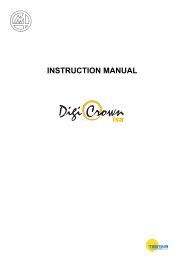Medical Metrology - Marposs
Medical Metrology - Marposs
Medical Metrology - Marposs
You also want an ePaper? Increase the reach of your titles
YUMPU automatically turns print PDFs into web optimized ePapers that Google loves.
<strong>Medical</strong><br />
<strong>Metrology</strong><br />
as Part of the Whole<br />
For those who manufacture medical devices, the thinking is personal. “We have<br />
the attitude that any of our parts could go into any of our children, or our mothers,<br />
tomorrow,” explains Jeff Corey, senior calibrations technician for ATEK <strong>Medical</strong><br />
(Grand Rapids, MI). ATEK is a Tier 1 medical device manufacturer with experience<br />
in clinical disciplines including cardiovascular, gynecologic, orthopedic, and spinal.<br />
<strong>Medical</strong> devices manufactured at the Grand Rapids facility range from plastic parts<br />
used in delicate heart surgeries to machined plates and screws made of bioresorbable<br />
protein for repairing skull and bone fractures.<br />
OGP’s SmartScope Specialist 300 delivers area accuracy of<br />
(1.5 µ + 5L/1000) with options that include scanning and<br />
touch-trigger probes, TTL lasers, microprobes, and rotary<br />
tables for additional axes of movement. Here, a prosthetic<br />
knee mounted on a rotary indexer is measured with a laser<br />
sensor on an OGP SmartScope Flash 302.<br />
<strong>Medical</strong> Manufacturing<br />
As in other industries,<br />
advanced metrology<br />
technology is finding<br />
a place closer to<br />
the medical-device<br />
production line.<br />
Bruce Morey<br />
Contributing Editor
<strong>Medical</strong> Manufacturing<br />
Such devices require precision measurements to ensure<br />
accuracy. Corey notes that the typical dimensional tolerances<br />
for most of his parts range from ±0.0005 to ±0.00025"<br />
(±0.013 to ±0.0064 mm). Measurements often called out<br />
include concentricity, flatness, hole diameters, and lengths.<br />
Many of the parts they measure are flexible plastic—a challenging<br />
material to measure repeatably and reliably with<br />
typical contact devices. “We are in a field where depth gages,<br />
micrometers, and rulers are giving way to 3-D laser technologies<br />
and CMMs equipped with vision,” remarks Corey,<br />
though he cautions that the industry will never completely<br />
eliminate using hand-held measurement tools or more<br />
traditional contact sensors. “Using progressive technologies<br />
means you can do more with less. Automated metrology<br />
tools are more repeatable and enable 24/7 operation, and results<br />
are not operator-dependent,” explains Corey. Variety is<br />
a hallmark, as is demanding precision. ATEK produces over<br />
1000 separate products. “The ability of a single system to<br />
replace multiple gadgets eliminates calibration time, processing<br />
cost, and redundant capital expense,” he remarks.<br />
Another potential key driver in the use of more advanced<br />
metrology, he notes, is how the industry is increasingly certifying<br />
vendors and their manufacturing processes, rather than<br />
their parts. “Certified vendors provide us components that, in<br />
turn, give us confidence in what we provide to our customers.<br />
Certification reduces the amount of inspection needed,”<br />
he explains. Instead of checking incoming components from<br />
these certified suppliers, ATEK measures critical dimensions<br />
and functions as a normal part of the manufacturing process.<br />
“<strong>Medical</strong>-device manufacturing, globally, is a growing<br />
market segment for us,” states Chris Bomgaars of Carl Zeiss<br />
Industrial <strong>Metrology</strong> LLC (Brighton, MI). He notes that the<br />
company offers metrology systems designed for measuring<br />
medical devices on the shop floor. One is the DuraMax CMM<br />
gage, a CMM equipped with a scanning tactile probe that<br />
does not need a special enclosure or room. The other is the<br />
O-Inspect multisensor system that combines vision and tactile<br />
probes. “Some medical device-companies have many of their<br />
metrology machines in their manufacturing cells, while others<br />
are certainly moving that way,” explains Bomgaars. “That is the<br />
Inspecting product for conformance with a Video Scope at ATEK <strong>Medical</strong>. Typical calibration accuracy<br />
ratio is 4:1 from standard to test unit at this company.
Carl Zeiss IMT’s O-Inspect multisensor system with a typical medical device.<br />
trend in all industries, not just medical; to move measuring<br />
onto the shop floor to reduce the time needed to gage a part.”<br />
Interestingly, for medical manufacturing he also sees that<br />
the abilities of their hardware to deliver measuring uncertainties<br />
are no more difficult than those encountered in production<br />
of many other precision goods. “There is a never-ending<br />
arms race to deliver ever-decreasing measuring uncertainties,”<br />
he says. <strong>Medical</strong>-device manufacturing is perhaps unique<br />
in the level of documentation required for each part. “They<br />
need to track the version control of the parts programs and<br />
archive parts programs so they can be called up at any time,”<br />
Bomgaars observes. To meet these needs, Carl Zeiss developed<br />
the Master Control Center package. “Once we understood the<br />
level of capability companies were going to need to document<br />
their process, that was a catalyst for creating the MCC software.<br />
The MCC controls version levels, and only released versions<br />
can run on the measuring machines. There is also a tool<br />
available to archive every run by, say, serial number or other<br />
unique identifier. This software also tracks machine utilization<br />
and predictive maintenance."<br />
Three-axis vision-based metrology systems are also wellsuited<br />
for a number of medical parts, notes Allen Cius, product<br />
specialist for vision systems for Mitutoyo (Aurora, IL). He<br />
lists such products as multilumen tubing, medical packaging,<br />
dental components, cardiac components, and orthopedic<br />
knees. Mitutoyo offers their multisensor QuickVision systems<br />
with an accuracy of 1.5 µ. Their QuickVision ULTRA system<br />
measures to 250 nm of accuracy in the X and Y-axes and 1.5<br />
µm in Z. “Our systems support process control, and are placed<br />
near production cells as well as used in more off-line, intensive<br />
QC tasks,” he says. In critical cases, where 100% inspection<br />
is required of components such as balloon catheters used in<br />
angioplasty, robots feed parts to a QuickVision system. “The<br />
advantage to the user is that a multivision system is capable of<br />
both first-article inspection—a much more lengthy process—<br />
and subsequent process control,” explains Cius.<br />
Like any other industries, medical manufacturing strives to<br />
produce quality parts at lower cost and with faster processing<br />
times. Cius points to the QV Stream vision-based system for<br />
high-throughput applications. While it offers 1.5-µ accuracy,
<strong>Medical</strong> Manufacturing<br />
what is unique is that the system uses stroboscopic illumination<br />
and a progressive scan camera to boost speed up to five<br />
times when compared to conventional processing, according<br />
to the company. “This system never stops moving,” explains<br />
Cius, while conventional systems move, stop, collect data,<br />
and move again. “This capability would be especially useful<br />
in products like multilumen tubings or medical packaging—<br />
soft parts where noncontact measurement is needed and the<br />
parts are made in high volume,” he observes. New in 2010<br />
for the QV Stream System was improved concurrent-image<br />
processing that can measure nonlinear data points through an<br />
interpolated path. “This makes it more useful for a wider array<br />
of medical parts,” says Cius. “<strong>Medical</strong> device parts are getting<br />
smaller to be less invasive in the body. As they shrink, we need<br />
to measure ever-smaller parts and tolerances.”<br />
The VisionGauge optical digital comparator<br />
can be fully automated if desired, according<br />
to VISIONx, reducing operator variability<br />
and speeding throughput.<br />
A tool frequently used for near-process measurements in<br />
manufacturing cells are optical comparators. These devices<br />
project a magnified silhouette of a part on a screen. Operators<br />
check the dimensions and geometry of the part against limits,<br />
using Mylar overlays. Generally easy to use by shop-floor<br />
personnel, and relatively easy on the capital budget, they are<br />
popular metrology tools for manufacturers of irregular parts,<br />
according to Patrick Beauchemin, an engineer with VISIONx<br />
(Pointe-Claire, Quebec, Canada). These components include<br />
orthopedic replacement knees, hips, bonescrews, and craniomaxialfacial<br />
implants. Handling the overlays, making sure the<br />
part number is at the right revision level, and accounting for<br />
operator differences are known issues with these devices.<br />
“A few of our medical device manufacturers urged us to<br />
adapt our vision systems and software to create a digital optical<br />
comparator,” explains Beauchemin. Enter the VisionGauge<br />
digital optical comparator. Using machine vision instead of<br />
optics, the system has the look and feel of an optical comparator,<br />
but compares images of parts directly with CAD data in<br />
DXF format, eliminating a hard overlay. Images are stored and<br />
deviations recorded digitally, without human intervention.<br />
A full range of magnifications is possible—5, 10, 20, 50 and<br />
100×—for a range of accuracies. “For example, at 50× magnification,<br />
we can deliver 0.0001" [0.003 mm] measurement<br />
uncertainty,” explains Beauchemin.<br />
The development of this device by VISIONx illustrates<br />
how new technology may best be served by putting it in a<br />
familiar form. The company’s previous experience is primarily<br />
automated imaging, visual inspection, and high-accuracy<br />
measurement solutions. It does not offer traditional optical<br />
comparators in its product lineup. “We ‘back-fitted’ this new<br />
technology into something they are familiar with,” remarks<br />
Beauchemin. He also points out that it offers many new possibilities,<br />
such as an automatic pass/fail capability. VisionGauge<br />
products are marketed, demonstrated, and exclusively sold,<br />
distributed, and supported throughout North America by<br />
Methods Machine Tools Inc. (Sudbury, MA).<br />
Another category of devices that might see more of a future<br />
in medical manufacturing is laser scanners. Traditionally, their<br />
speed advantage was offset by less accuracy and the need to<br />
coat or treat reflective surfaces. “The biggest shift we’ve seen<br />
is that, as laser technology matures, we are more capable of<br />
scanning shiny surfaces, such as those typical in orthopedic<br />
replacement parts, such as knees and hips,” comments Alex<br />
Lucas, business development manager of scanning products<br />
for Nikon <strong>Metrology</strong> (Brighton, MI). <strong>Medical</strong> manufacturers<br />
and the FDA frown on unnecessary chemical treatments<br />
on parts going into a human body. Lucas points to the Nikon<br />
LC60Dx as a device with an upgraded capability to collect data<br />
from shiny and other challenging surfaces.<br />
Even so, a scanner is not as accurate as a typical tactile<br />
probe, a fact Lucas himself points out. “Speed is its best attribute,<br />
and a lot of our customers are getting comfortable<br />
scanning 100% of a part or parts to, say, 75% of their desired<br />
accuracy specification,” explains Lucas. What are the advantages<br />
of more, fast measurement made less accurately? “That<br />
volume of data allows them to do trend analysis and macro<br />
analysis of their parts,” he says. “They then can follow up on<br />
specific parts with tactile probes on a few parts with higher<br />
accuracy,” based on the trends identified. He notes that he sees<br />
many customers choosing to upgrade existing tactile probe<br />
CMMs with an additional laser scanner.<br />
Equipment for measuring is one thing, reporting and<br />
documenting results is another. Optical Gaging Products<br />
(OGP; Rochester, NY) is another supplier of multisensor
systems as well as advanced hybrid digital/optical comparators,<br />
specifically tailored for the medical market. Because<br />
the market is growing, a number of smaller shops that once<br />
made only automotive or aerospace parts are now making a<br />
transition to producing medical parts, according to Nate Rose,<br />
chief application engineer<br />
for OGP. “I think one of the<br />
biggest challenges in medical<br />
device metrology is meeting<br />
FDA requirements,”<br />
he states. “For example, in<br />
manufacturing environments<br />
outside of medical, they may<br />
not give a second thought<br />
to fine-tuning an inspection<br />
routine at any time. When<br />
the FDA is an overseer, even<br />
minor program changes are a<br />
big no-no. Once a process is<br />
validated and they are using<br />
it to make parts, even a small<br />
change requires revalidating<br />
it.” OGP, recognizing this situation,<br />
invested in developing<br />
software specifically aimed at<br />
helping manufacturers with<br />
FDA compliance. OGP offers<br />
the ability to run subsets of<br />
validated inspection routines,<br />
so manufacturers can test specific<br />
features without the need<br />
to run the entire routine or to modify the validated routine in<br />
any way. Rose goes on to note that: “This allows the ability to<br />
work from a validated first-article inspection routine and run<br />
smaller batch-style inspections consistent with critical dimensions.”<br />
While developing new sensor technology, OGP has<br />
also grown its offerings in software solutions for processing<br />
measurement data with its SmartProfile software. “Conventional<br />
measurement involves widths, distances, diameters, etc.<br />
On spines and knees, however, those kinds of dimensions are<br />
nonexistent,” says Rose. Using point clouds from the measuring<br />
machine as basic input, SmartProfile analyzes the dimensional<br />
measurement data for conformance of 3-D shape, form,<br />
and dimensions of rigid parts to a CAD model, relative to the<br />
ASME Y-14.5 GD&T standard. “Demonstrating that you meet<br />
that standard is especially important in the medical community<br />
right now,” explains Rose.<br />
Compared to many other industries, medical device manufacturing<br />
has unique concerns about patient welfare, with<br />
lingering thoughts of liability. “These concerns drive extreme<br />
process control,” explains Frank Powell, product manager for<br />
<strong>Marposs</strong> (Auburn Hills, MI), a provider of in-process gaging<br />
and measurement equipment. “We have installed systems that<br />
use a 2-D bar code on each part to relate gaging data, what operation<br />
it was measured on, what the measurements were, and<br />
even which machine it was made on and who was the operator<br />
at the time,” he says.<br />
Nikon <strong>Metrology</strong>’s LC60Dx collects up to 75,000 points/sec to a measuring<br />
uncertainty of 9 µ (0.0004") at 1 sigma with measured results often as low<br />
as 7 µ (0.0003") at 1 sigma.<br />
MARCH 2012<br />
Another example of the extreme care sometimes needed<br />
in medical device manufacturing was the company’s experience<br />
in developing a mark-free measuring system for titanium<br />
hip joints. The ball and socket have to mate perfectly, requiring<br />
a superfinish for a nearly friction-free range of motion.<br />
Specialized machine tools create the superfinish. In-process<br />
gages monitor and control these machines. The problem is<br />
that titanium is a highly reactive metal that attaches readily<br />
to carbon-based materials, such as the diamond commonly<br />
used for precision gage contacts. The buildup on the carbonbased<br />
contacts led to inaccuracies. Modern ceramics provide<br />
the best wear characteristics. Machining processes using<br />
contact gages can leave a mark on the workpiece. In most<br />
cases, it would not affect the functional performance of the<br />
artificial joint. As Powell points out, however: “Surgeons are<br />
not metrologists.” If they see a mark, concerns over patient<br />
welfare will lead them to reject and scrap the part. In response,<br />
<strong>Marposs</strong> works with process engineers and machine builders<br />
to fine-tune the grinding process to prevent visible marks.<br />
Powell concludes that more inspection systems will be needed<br />
to control quality in the future.<br />
Copyright Notice: 2012 Copyright by SoCiety of ManufaCturing engineerS.<br />
all rightS retained. uSer May not Save any text or graphiCal iteMS to<br />
hard driveS or dupliCate thiS artiCle in whole or in part in any MediuM<br />
thiS uSage with perMiSSion froM ManufaCturing engineering®, the offiCial<br />
publiCation of the SoCiety of ManufaCturing engineerS (SMe). www.SMe.org.”



